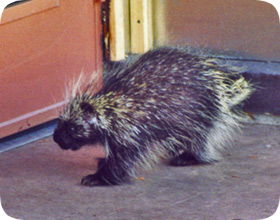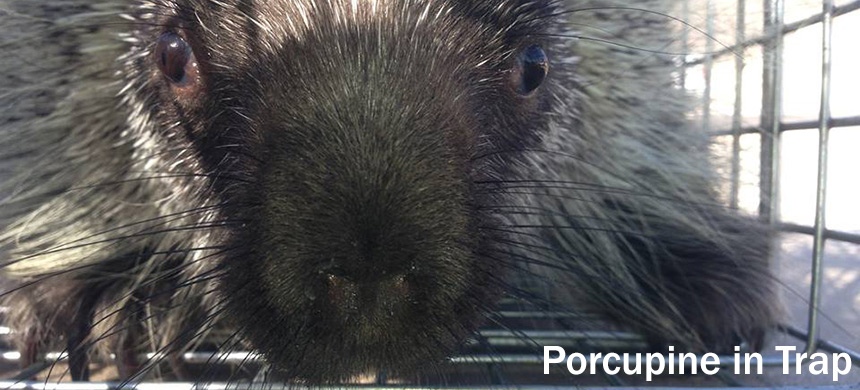-
info@aaanimalcontrol.com
Call us for help in your town
Humane Wildlife Education
Porcupine Removal - How to Get Rid of Porcupines
We are experts in porcupine control methods, having performed thousands of porcupine trapping and removal jobs nationwide.
 Have you ever wondered how the porcupine got its name? Well, porcupine means
“one who rises up in anger” which is a great reference to the porcupine
itself, considering it has quills that stand up on its body letting all
predators know that they will not be an easy meal to obtain. However,
porcupines do have soft hair in certain spots and they can weigh up to 35
lbs. With their large round bodies, you can count on them moving slower than
ever. They can come in many different shades such as grayish, white and
brown. You can often find them in Africa, America and Southern Asia with
long tails that can stretch up to eight inches in size. Making an occasional
appearance in the daytime, these rodents enjoy living in trees and rocks in the hillsides,
forests, rocky outcrops and deserts. These rodents are excellent climbers considering they can climb trees that are up to 70 feet high.
Have you ever wondered how the porcupine got its name? Well, porcupine means
“one who rises up in anger” which is a great reference to the porcupine
itself, considering it has quills that stand up on its body letting all
predators know that they will not be an easy meal to obtain. However,
porcupines do have soft hair in certain spots and they can weigh up to 35
lbs. With their large round bodies, you can count on them moving slower than
ever. They can come in many different shades such as grayish, white and
brown. You can often find them in Africa, America and Southern Asia with
long tails that can stretch up to eight inches in size. Making an occasional
appearance in the daytime, these rodents enjoy living in trees and rocks in the hillsides,
forests, rocky outcrops and deserts. These rodents are excellent climbers considering they can climb trees that are up to 70 feet high.
Need porcupine removal in your hometown? We service over 500 USA locations! Click here to hire us in your town and check prices - updated for year 2020.

What They Eat
Porcupines are known for eating twigs, tree bark, leaves and herbaceous plants. Yet, they do have a preference such as cottonwood, ponderosa pine and willow. For them, a tree that consists of bark that is smooth is much tastier than the rough bark. They will often gnaw away on different types of wood outside or inside of the home that has been lavished with the sweat of humans just to obtain the salt from them. They can even do some damage to some fruits and succulent plants in crops and gardens
Porcupine Nuisances
Just because a porcupine has poor eyesight and moves very slowly does not mean that they can be a nuisance. In fact, they can be destructive to vegetation, trees and they can even damage your furniture and some tools where humans have left sweat behind on them. Also if your children or pets come in contact with them, they might be in for a prickly surprise.
How to Get Rid of Them
Removing a porcupine doesn't have to be painful for them or you which is why live traps are recommended. They are effective and allow you to capture them without delivering a shock or anything else painful to these rodents. Before setting a trap for the rodent look for the area that they have damaged. Once you've found it, set the wire cage or wooden box nearby. Inside of the cage you should place a piece of wood soaked in salt and vegetable oil inside near the very end/back of the cage. If you want to make it even easier for you to catch him, rub some of the oil on a trail leading to the cage so that it will lead the porcupine all the way back to the cage. Once the porcupine finds the food, they will make their way to it to drain the salt from it. When the porcupine tries to get the food, the door will snap shut with the porcupine inside. Now, you can remove him from your yard and relocate him to an area that is non-agricultural. Porcupines should never be removed by hand because they will feel threatened and their prickles will rise in an attempt to hurt you.
Read more on my detailed how to trap a porcupine page.
Electric Fences
Electric fences can also be an effective solution when put up properly. High poultry wire that is at least 60 cm high is used to enclose the area. Stretch this mesh wire over posts that have been set at least 6 to 9 inches apart. The bottom of the wire mesh should be secured below ground level. While electric fences can be effective, they do so by harming the porcupines which is not recommended. They may also harm other animals including your pets and/or livestock as well as children and other people.
Read more on my detailed how to keep away porcupines page.
Porcupine Repellents
As you may already know, there are thousands of products on the market being advertised to get rid of porcupines such as repellants. Repellants can be sprayed on any plants that you don't want the porcupines to eat. They give the plants a bitter taste that porcupines prefer not to ingest. However, these repellants can be harmful to animals and humans who consume them. They also have to be reapplied over and over again which can get pretty expensive. With the economy in its current state, not everyone can afford to keep spending money on repellants that may or may not work and that you will need to constantly reapply.
SOME SPECIFIC PORCUPINE AREAS OF INTEREST:
How To Get Rid Of Porcupines In The Garden
Your garden can be heaven for many wildlife animals and porcupines are not the exception. Though they are likely to be satisfied with a bark diet, if they find a garden with plants that they like or vegetables they are likely to keep coming back until it is destroyed. So what are your options when a porcupine has decided to make a feast out of your garden? The first thing that you could do is to fence your garden to prevent porcupines from coming in. Those fences need to cover underground and be on an outwards incline as porcupines are actually great climbers.
Another option for the fencing could be to use an electric fence. Of course you need to be careful not to come in contact with it, but even if you do the voltage is usually not enough to cause an injury. If the electric fence is a bit too much then you can get live traps. It is a good idea to get traps that are designed specifically for porcupines because since they can get rather large, other traps may not be effective. Get a trap for weights of up to 40 lbs. as a porcupine could weigh up to 35 lbs.
How To Get Rid Of Porcupines In Garage
Just like any other animal in the wild, a porcupine is likely to search for two things: food and shelter. While in some cases the garage can provide both of those things if you leave pet food in the garage, usually the main reason a porcupine will go in there is to get shelter. The garage is one of the best places in a home for a porcupine to remain warm and dry. The garage may not have as much human traffic to scare it away, and the heat that comes into the garage from the house may provide extra comfort is for the animal.
If there is not enough food nearby then using traps can be easy and effective. Get some fresh veggies in it or even soft tree bark and the porcupine will be drawn in. Make sure not to go into the garage for 24 hours or until you know that the porcupine has set the trap off. The waiting period is so that the porcupine is comfortable enough to go into the trap. Once you have released the porcupine away from the garage, make sure that you close up any access points wild life may have to it.
How To Get Rid Of Porcupines In Crawlspace
Getting any type of wildlife in the crawlspace of a house can be not only inconvenient; it can in some cases be dangerous. A crawlspace does not have enough room for you to react when you see an animal. An animal that feels cornered can also be dangerous as it has two options which are fight or flight. Though a porcupine will in most cases choose flight if it is injured it may feel threatened enough to put up a fight, and since they are not exactly small rodents it can be a scary sight.
To get rid of porcupines in the crawlspace then you need to use traps, because other means of catching it can be too difficult. The traps should be big enough for the porcupine, so if you have enough room purchase one for 35lbs. The crawlspace makes trapping a bit more difficult, but the right trap can help you catch it even without professional help. If the trap does not have enough room to separate you from the animal, then make sure that you wear thick gloves to hold the trap until you have enough room to be safe. The quills can cause injury so make sure that you protect yourself.
How To Get Rid Of Porcupines In Yard
Though porcupines exhibit poor eyesight they can still be a pest and they can still pose a danger to your pets and family. They are rather slow, but do not let their slow movements fool you. They love to eat the vegetation in your yard including trees, vegetation and in some extreme cases even some tools. Because of the damage that they can cause you need to know how to get rid of porcupines when they come into the yard. The first step is to take away the things that are attracting them to your yard so that they have no incentive to be there in the first place.
Because porcupines love tree bark and because they are actually good tree climbers it may not be feasible to remove the trees. Fencing the porcupines out of the yard however is a perfectly reasonable thing to do. You need tall fences which are inclined outwards from the tree. That will make it almost impossible for the porcupines to climb. The same should be done with gardens and vegetation which porcupines may be going into. If the porcupines are still coming, then you should use traps to trap and release them far from your property.








































